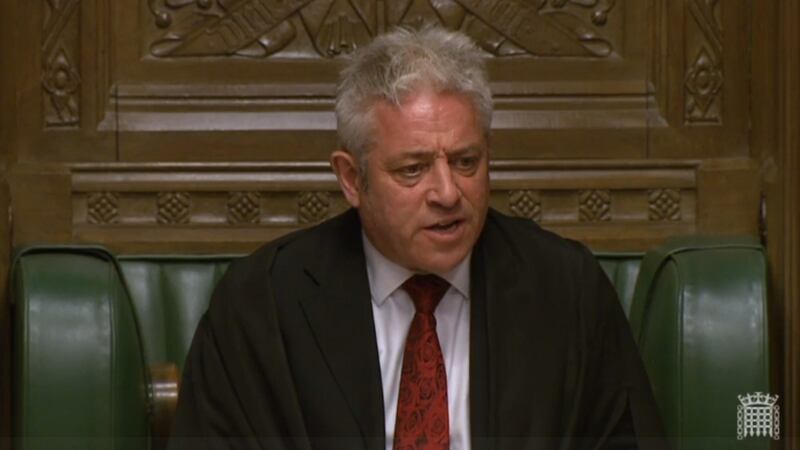The idea of multi-option or “indicative” voting is not alien to the House of Commons. However, British MPs have yet to show they can run such a vote properly.
In 2003, the parliament carried out a series of majority votes to settle the issue of House of Lords reform, a debate which was already 100 years old. Some said the House should remain “all appointed”, many said it should be “all elected”, and several said there should be a compromise. There were three proposals: 20:80, 50:50 and 80:20.
The idea was to have five majority votes. But that would be "daft," said Lord Desai; how do people vote on their 2nd preference? What happens if there are majorities for more than one option?
Many people think that “democracy is based on decisions taken by a majority”. So Westminster took five majority votes and lost them all.
And now to Brexit. The problem is not binary. Binary voting is adequate when the problem itself is binary but, in a plural society, in a pluralist democracy, and in any debate on a problem which is complex and/or controversial, there are usually more than two options "on the table".
Sometimes, admittedly, problems are binary. Take, for example, the question, “which side of the road shall we drive on?”
Believe it or not, the only country to have a referendum on this problem, Sweden, had three options on the ballot paper: “left”, “right” and “blank”. Those committed democrats who on this particular topic were actually indifferent could vote “blank” and, as it were, go with the flow. It was November, 1955. There was no electronic voting in those days, and 40,000 people put on their boots to go to the polling station to vote “blank”.
Multi-option voting is possible, as the Citizens' Assembly in Ireland confirmed
A more difficult problem was debated in New Zealand in 1992 - their electoral system. Much to the chagrin of the political parties, an independent commission was tasked to take submissions and produce a short list to represent the debate.
As a result, they finished with a five-option referendum so nearly everyone could vote for something that they actually wanted and, in a two-round system, they chose a compromise - the German system of half PR (proportional representation) and half first-past-the-post.
So multi-option voting is possible, as the Citizens’ Assembly in Ireland confirmed. If there are only two options, then it’s a majority vote, albeit simple or weighted, but there is only one way of counting - so many “for” and so many “against”. With multi-option voting, however, there are quite a few ways of doing things. They include:
* a plurality vote, to see which option gets the most 1st preferences (which is like the British first-past-the-post electoral system);
* a knock-out system, either a two-round system as used in New Zealand and in French elections, or the alternative vote which is like the Irish single transferable vote when electing only one person, as in Irish presidential elections;
* an open system called approval voting, where MPs “approve” of how ever many options they want, but it is not preferential; and
* a points system, in which at best the option with the most points or the highest average preference comes out on top.
The Citizens’ Assembly experimented with many of these various methodologies and, partly as a result, concluded that in future referendums, a multi-option format should be allowed.

In a similar though rather more frenzied fashion, Westminster is also discussing how best to take indicative votes on Brexit.
Prime minister Theresa May mentioned only a series of majority votes and in a rather critical way (then again, maybe she wants them all to fail). Professor Meg Russell discussed a two-round vote. Liberal Democrats leader Vince Cable suggested the alternative vote.
Kenneth Clarke and Oliver Letwin both want something like Lord Desai's idea of a preferential vote. But Hilary Benn, who has long argued for an indicative vote, suggested a form of approval voting, but that is just more binary votes, which could be just as "daft" as it was in 2003.
Kenneth Clarke's idea, however, if it allows for partial voting, could be the best way. Allow the MPs to make their various suggestions; Speaker John Bercow then forms a list of viable options; and the MPs then cast their preferences as follows:
If there are to be six options - A, B, C, D, E and F, say - each can cast as many preferences as they like. If one MP casts four preferences, he gives his favourite 4 points, his second choice 3, his third choice 2 and his fourth choice 1 point. If another casts just two preferences, she gives her favourite 2 points and her second choice 1 point.
This methodology was invented by Jean-Charles de Borda in 1774. It is very accurate and according to the Oxford Concise Dictionary of Politics, it is one of the “best interpretations of majority rule.”
It was adopted in the French Académie des Sciences in 1784 at a time of political turmoil even worse than that of Brexit: the revolution came five years later. There was then a new man in charge of the Academy who said, in effect, ‘Let’s forget all this consensus nonsense and go back to majority voting’. And he, not best known for his democratic idealism, was one Napoléon Bonaparte.
* Peter Emerson and Phil Kearney are members of the de Borda Institute, a Northern Ireland-based organisation which promotes the use of inclusive voting procedures on all contentious questions of social choice.










